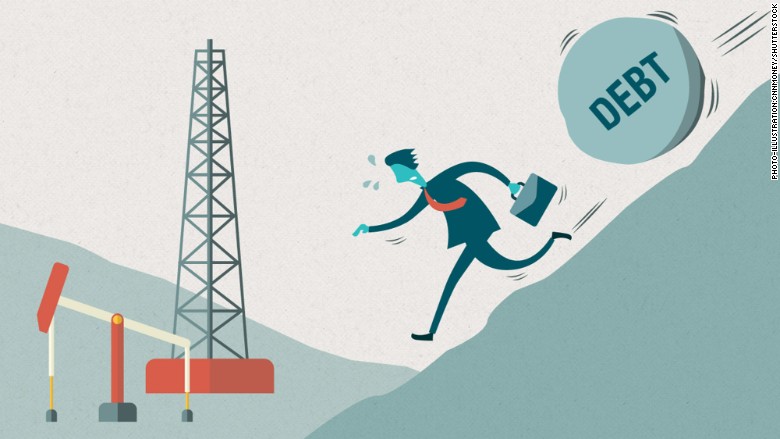Here's a crude reality: Oil prices are recovering too late to save many drillers drowning in tons of debt.
SandRidge Energy (SD)became
the latest victim of the oil crash, with the Oklahoma City-based shale
driller filing for Chapter 11 bankruptcy on Monday.
Based on roughly $4 billion of debt, SandRidge is the second-biggest
oil-focused U.S. company to file for bankruptcy during the current oil
bust, according to a CNNMoney analysis of stats compiled by law firm
Haynes and Boone.
The biggest bankruptcy took place just last week when Linn Energy (LINE)filed
for Chapter 11 with more than $10 billion in debt. Other bankruptcy
filings in recent days include energy exploration and production company
Breitburn Energy Partners (BBEP) on Sunday and shale driller Penn Virginia (PVA) last week.
It's a sign of the continued struggles despite the 80% spike in oil prices
since mid-February to around $47.50 a barrel today. Oil companies
continue to grapple with diminished cash flows as they've cut back on
production and contend with low prices.
All of this makes it
very difficult to pay back the debt they piled up just a few years ago
when oil prices were comfortably sitting above $100 a barrel. Hence, the
boom-to-bust nature of the oil business.

There have already been at least 29 U.S. oil and gas bankruptcies this
year alone, according to Haynes and Boone. That brings the toll since
the start of last year to at least 64.
The default rate among
exploration and production junk bonds has soared to a record 27% over
the past 12 months, according to a recent Fitch Ratings report. Fitch
thinks the default rate could hit 35% by the end of 2016.
George Koutsonicolis, managing director at oil restructuring firm SOLIC
Capital, believes more bankruptcies are coming, especially among smaller
drillers.
"The industry has historically been full of
wildcatters and speculators. It's not surprising we're going through
this boom-and-bust cycle," Koutsonicolis said.
Just look at SandRidge, which hinted at a possible bankruptcy
in March. The company's stock was trading at $80 apiece back in 2008,
but today it's worth just 2 cents. SandRidge piled on debt to pay for
its drilling efforts in the U.S.
But SandRidge suffered a 32%
plunge in oil production during the fourth quarter of last year. And
each barrel of oil sold for just $46 last year, compared with $90 in
2014. Natural gas revenue has also been squeezed by depressed gas
prices. SandRidge tried to reduce leverage in recent months by slashing
spending, selling assets and negotiating with lenders.

The bankruptcy plan calls for
SandRidge to convert about $3.7 billion of debt into equity, slimming
down the company's bloated balance sheet.
"We are pleased that
our creditors recognize the long-term value SandRidge and its employees
can create with an improved balance sheet," SandRidge CEO James Bennett
said in a statement.
SandRidge said it will continue paying
employees, vendors and suppliers during the bankruptcy. The company
believes it will have "ample liquidity" after emerging from Chapter 11,
meaning it won't need to borrow more money to fund its drilling
operations in Oklahoma and Colorado.
Hoping to reassure
employees, SandRidge also said it does not "anticipate any job losses"
as a result of the bankruptcy filing.
No comments:
Post a Comment